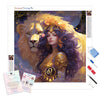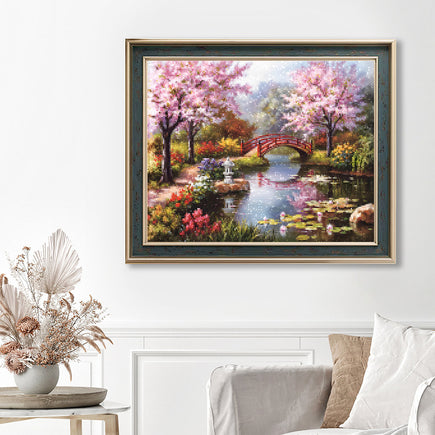The Ultimate Setup: How to Design Your Perfect Diamond Painting Workstation
Have you ever experienced sitting down to diamond paint on the kitchen table, only to find that you were rushed to shove everything back in boxes by dinnertime? While diamond painting can be done anywhere, having a dedicated space signals to everyone that your hobby is a serious, valued pursuit.
The first step to a perfect diamond painting experience is designating a permanent creative zone. This guide will walk you through choosing and transforming the right space for your needs, regardless of home size, so you can claim your creative territory today!

Phase 1: Choosing Your Ideal Location
The perfect spot is a balance of space, light, and quiet. Here is how to evaluate potential areas in your home:
1. Assess Your Space
Before even moving any furniture, be realistic about the size of your project:
- Large Canvases/Multi-Panels: If you are creating a large-scale work (40 cm x 60 cm and above) or a multi-panel diamond painting, you will need to prepare an entire desktop for your creation.
- Smaller Projects/Portability: If you work on smaller projects, a more compact solution will do the trick, such as a corner desk, a folding-down mounted table (Murphy desk) or a wheeled utility cart (perfect for fitting in a closet or a long hallway niche).
2. Prioritize Light and Power
Your chosen area must support your primary tools:
- Electricity Source: The area needs to be easily accessible to electricity, because again the things you will regularly use will be the light pad and your auxiliary
Pro Tip: Having a surge protector strip mounted beneath your desk or work surface can help keep your area tidy.
- Natural Light Advantage: Favor areas near a window, as natural light is best for accurate color perception. However, avoid areas that get direct, harsh afternoon sun, which can cause terrible glare on the shiny drills. North-facing windows usually offer the best, most consistent light for crafting.
3. The Noise and Distraction Factor
Diamond painting offers a beautiful meditative state, but the wrong room can entirely throw you off track.
- Goal: Choose a neutral and low-traffic room. A quiet corner in a typically unused guest room, or a spare closet is great for the added benefit of being able to close the door when you are done; or, you could dedicate a nook in the basement or attic.
- Benefit: A quiet area will allow you to fully achieve a "flow state." It deepens your concentration and makes the passage of time seem to disappear.

Phase 2: Converting the Space
Once you've identified the perfect location, it's time to furnish and define your creative zone.
4. Selecting the Core Furniture
Your workspace should be stable, large enough for the canvas, and comfortable.
- Dedicated Table: Choose a dedicated table that youwill not need to clear constantly. A small corner desk that is sturdy would be great or a folding table, or an adjustable drafting table that allows your canvas to be tilted for better ergonomics.
- The Right Chair: This is important since you will be spending hours here. Make the investment in an ergonomic chair, with lumbar support, and adjustable armrests. If you do not have the budget for a new chair, placing a firm pillow or rolled-up towel for lower back support is a good alternative.
5. Utilizing Vertical Space
Floor space is almost always limited, so look up!
- Storage Solutions: Use wall shelving over your desk space, pegboards for hanging tools, or roll-around utility carts for drill storage and mobility.
- Benefit: Keeping drills, trays, and storage containers off the work surface ensures you have maximum canvas space and reduces the risk of accidental spills.
6. Defining the Zone
If your desk is situated in a shared room, you will likely need a visual marker, or cues, to show that your space is reserved and to signal "Do Not Disturb."
Visual Cues: Utilize a privacy screen, a standing room divider, or a tall, opaque bookshelf to provide visual separation for your studio and reduce interruptions. Additionally, it gives you permission to avoid cleaning and putting away your project so it is available for you to jump right back into it.
Phase 3: Optimizing the Setup
Once your furniture is in place, you can focus on the detailed elements that enhance comfort and efficiency.
7. Layering the Lighting
Don't rely only on the room light. Install your light pad directly under the canvas, and add a bright, flexible LED task lamp positioned over your shoulder to eliminate shadows and reduce eye strain. Choose a lamp head that can easily pivot.
8. Implementing an Organization System
Set up your drill organization right next to your work surface. Whether you choose tackle boxes, small labeled bead organizers, or a binder filled with clear zipper bags, ensure they are accessible and clearly labeled with DMC numbers for lightning-fast color swapping.

9. Essential Comfort Gear
Remember the ergonomic details. Use ergonomic diamond pen and, if you use a light pad frequently, try blue light blocking glasses to reduce eye fatigue from the bright screen. The more comfortable you are, the longer you can enjoy your focused painting time.
Your Creativity Hub Awaits
The value of a dedicated studio isn't the furniture—it’s the permission it grants you to immerse yourself fully in the hobby. By following these steps to assess, furnish, and optimize a corner of your home, you transform a casual pastime into a comfortable, productive retreat. Stop pushing your art aside for dinner, and start creating in a space that truly supports your passion!
Ready to start optimizing your space? Which underutilized corner of your home will you claim as your diamond painting studio today?

























